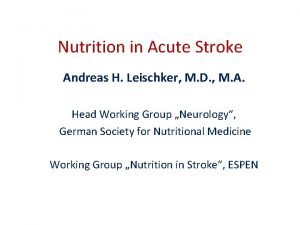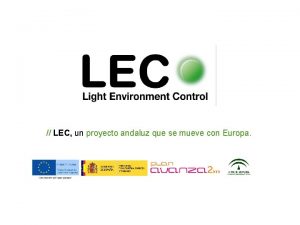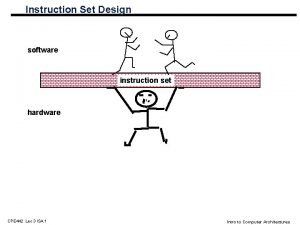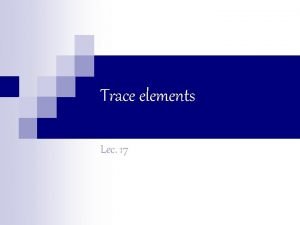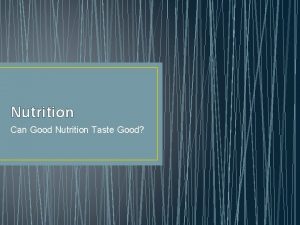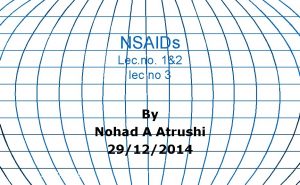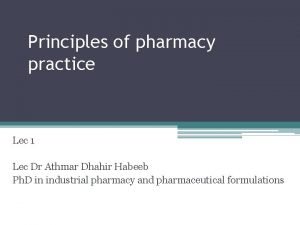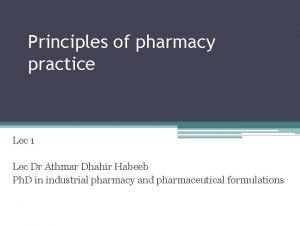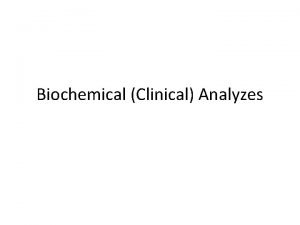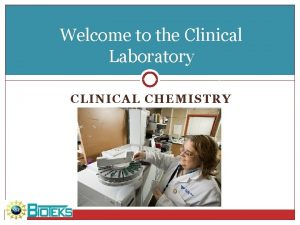Clinical nutrition Lec 15 n Good nutrition is


















- Slides: 18

Clinical nutrition Lec. 15

n Good nutrition is essential to good health. Food furnishes your body with chemical substances called nutrients, which are essential for life. These nutrients are necessary for building, repairing and maintaining cells and body tissues, regulating the body processes, and providing energy. To survive, we must eat a certain amount of nutrients.

Nutrients are grouped into 6 different classes: n Carbohydrates n Fats (Lipids) n Protein n Vitamins n Minerals n Water

General functions of nutrients n Fuel (energy) is expressed in kcal n Building materials for body structures n Regulation & control of body processes

Vitamins are nutrients required in tiny amounts for essential metabolic reactions in the body. The term vitamin does not include other essential nutrients such as dietary minerals, essential fatty acids, or essential amino acids. n They are bio-molecules that act both as catalysts and substrates in chemical reactions. When acting as a catalyst, vitamins are bound to enzymes and are called cofactors such as (Thiamin Vit. B 1) n

Vitamins also act as coenzymes to carry chemical groups between enzymes. Folic acid, for example, carries various forms of carbon groups–methyl, formyl or methylene in the cell. n If there is serious deficiency in one or more of these nutrients, a child may develop a deficiency disease n

Vitamin Deficiencies n n n Not getting enough of the vitamin in the food. limits the absorption or use of the vitamin. Impaired metabolism. Increased requirements. Increased losses.

Humans do not store most vitamins in their bodies, so a human must consume them regularly to avoid deficiency. n vitamins A, D, and B 12 are stored in significant amounts in the human body, mainly in the liver. n Well-known human vitamin deficiencies involve thiamine (beri), niacin (pellagra), vitamin C (scurvy) and vitamin D (rickets). n

Water – soluble vitamins Vitamin B 1 Thiamin pyrophosphate n n It is a cofactor in the metabolism of pyruvate and 2 -oxoglutarate to acetyl Co. A and succinyl Co. A. In the reaction catalyzed by the enzyme transketolase. Thiamin is involved in numerous body functions, including: nervous system and muscle functioning and flow of electrolytes in and out of nerve and muscle cells. In the production of hydrochloric acid (which is necessary for proper digestion).

Because there is very little thiamin stored in the body, depletion can occur as quickly as within 14 days. n Severe chronic thiamin deficiency can result in potentially serious complications involving the nervous system/brain, muscles, heart, and gastrointestinal system. n Measurement of plasma pyruvate conc. an excessive rise is seen in thiamin deficiency ( thiamin is cofactor of conversion of pyruvate to acetyl Co. A) n The most sensitive method is detecting transeketolase in RBC haemolysate. n

Nicotinic acid It is commonly known as niacin, it is a form of vitamin B 3. n Nicotinic acid is a precursor of nicotinamide n It is involved in a wide range of biological processes, including the production of energy NAD (Glycolysis), the synthesis of fatty acids NADP (Pentose phosphate), cholesterol and steroids. n tryptophan found in the proteins is metabolized to niacin. n

The deficiency syndrome, pllagra (meaning rough or smarting skin) can result from either an inadequate dietary intake of nicotinic acid or decrease synthesis. n Increase metabolism of tryptophan to hydroxyindoles will cause a decrease in nicotinic acid synthesis. n Nicotinic acid assessed either by assay of the vit. in plasma or measurment of its urinary metabolites. n

Folic acid Purine and pyrimidine are derivative of folic acid. n Folic acid deficiency cause microcytic anaemia with megaloplastic marrow changes. (it is an indicator for megaloplastic aneamia) n It is measured by immunoassay. n The conc. of folate in red cells is more accurate than that in plasma. n Folate is used in pregnancy to reduce the risk of neural tube defects. n

Vitamin B 12 - Cobalamins It is essential to nucleic acid synthesis. n Its deficiency can cause megaloplastic anaemia and neurological manifestations. n Dietary deficiency is rare except in strict vegetarians. n Considerable amonts are stored in the liver. n

Vit. B 12 deficiency is commonly in pernicious anaemia. (autoimmune disease) due to the lack of intrinsic factor essential for the absorption of the vitamin from the gut. n This vitamin is measured in plasma by immunoassay. n

Vitamin C – Ascorbic acid n n Ascorbic acid is essential for the hydroxylation of proline residues in collagen (for normal structure and function of this protein). It act as antioxidant by keep the iron in the hydroxylating enzyme in the reducrd form (Fe 2+). It facilitates the intestinal absorption of dietary non haem iron by keeping it in the Fe 2+ state. Deficiency is common in housebound people.

Its conc. in plasma is poor index of tissue stores of the vitamin. n Its conc. In plasma reflect recent dietary intake. n It is better to assess its conc. In leucocytes. n

 Tom hello good morning
Tom hello good morning Good evening students
Good evening students If you are
If you are Zoroastrianism good thoughts good words good deeds
Zoroastrianism good thoughts good words good deeds Good afternoon morning
Good afternoon morning Basics in clinical nutrition
Basics in clinical nutrition Leischker
Leischker Lec anatomia
Lec anatomia 11th chemistry thermodynamics lec 13
11th chemistry thermodynamics lec 13 Lec barbate
Lec barbate Xrl instruction in 8051
Xrl instruction in 8051 11th chemistry thermodynamics lec 10
11th chemistry thermodynamics lec 10 Lec
Lec Apelacin
Apelacin Lec hardver
Lec hardver Lec ditto
Lec ditto Lec hardver
Lec hardver Tura analítica
Tura analítica Lec element
Lec element






